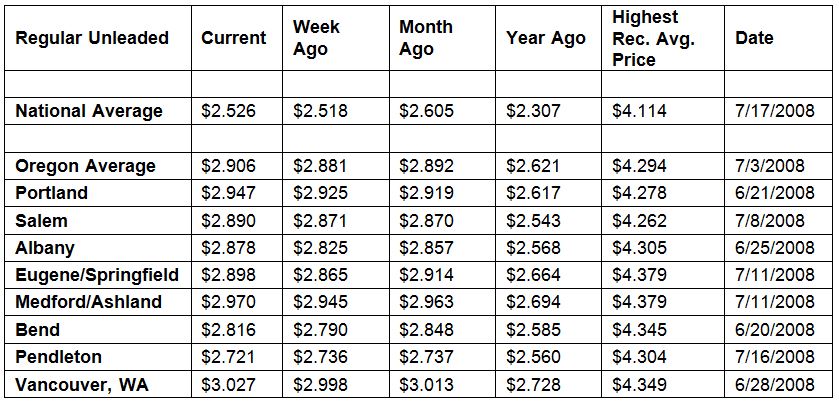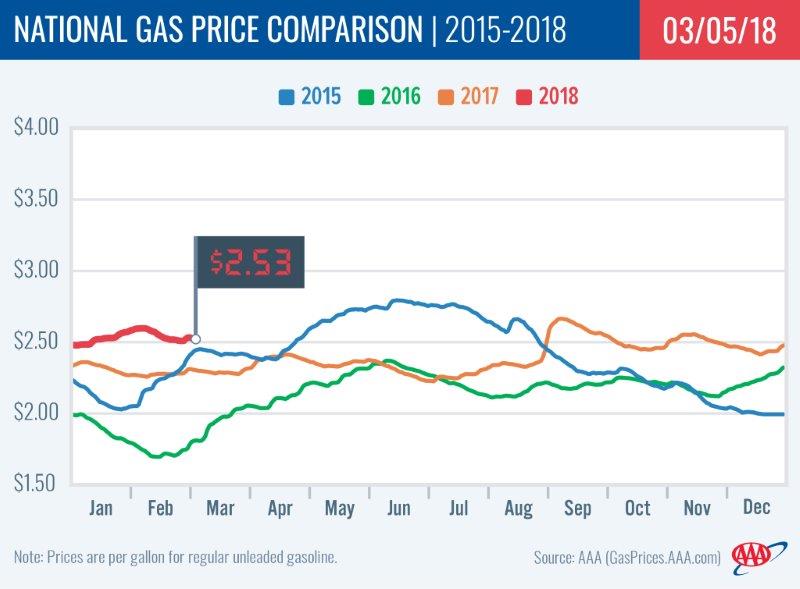PORTLAND, Ore., – After three weeks of steady or even declining pump prices, nearly half of the states, including Oregon, are seeing gas prices rise as the traditional late winter/early spring run-up begins. For the week, the national average for regular adds a penny to $2.53 a gallon while the Oregon average gains two-and-a-half cents to $2.91, which is a new year-to-date high for the Oregon average. The national average peaked for the year so far at $2.61 on Feb. 5.
“This is a volatile year so far for gasoline markets, due to fluctuating crude oil prices, robust demand for gasoline, and new U.S. oil production records,” says Marie Dodds, public affairs director for AAA Oregon/Idaho. “Normally, pump prices climb in March as the days get longer and people start to drive more. In addition, refinery maintenance season is underway, ahead of the switchover to the more expensive and cleaner burning summer blends.”
AAA expects gas prices to climb to their spring highs between around April 1 and June 21. Spring prices will be higher than the last couple of years, but likely not as expensive as in 2014 when the national average peaked at $3.70 and the Oregon average peaked at $3.99.
Oregon is one of 24 states where gas prices are higher week-over-week. The largest increase is in Ohio (+8 cents). The largest decrease is in New Jersey (-3 cents).
Oregon is one of six states where prices are higher now than a month ago. The national average is eight cents less and the Oregon average is one cent more than a month ago. The largest monthly increase is in Hawaii (+10 cents). The largest monthly decrease is in Kentucky (-14 cents).
The West Coast still has the most expensive gas prices in the nation with six of the top ten states in this region. Hawaii tops the list, followed by California, Alaska and Washington. These states are the only four with averages at or above $3 a gallon. Oregon is fifth most expensive for the fifth week in a row.
| Rank | Region | Price on 2/27/18 |
| 1 | Hawaii | $3.50 |
| 2 | California | $3.35 |
| 3 | Alaska | $3.08 |
| 4 | Washington | $3.00 |
| 5 | Oregon | $2.91 |
| 6 | Nevada | $2.80 |
| 7 | Pennsylvania | $2.78 |
| 8 | District of Columbia | $2.73 |
| 9 | New York | $2.71 |
| 10 | Connecticut | $2.68 |
According to the U.S. Energy Information Administration (EIA), gasoline inventories saw a draw down for the third consecutive week; decreasing by 1 million bbl. Still, inventories now sit at 33.2 million bbl, which is nearly 3 million bbl higher than they were at this time last year. Planned maintenance at refineries in the region has helped to lower stocks.
The nation’s cheapest markets are Alabama ($2.28) and South Carolina ($2.28). For the 32nd week in a row, no states have an average below $2.
Drivers in all 50 states and the District of Columbia are paying are paying more than a year ago to fill up. The national average is 22 cents more and the Oregon average is 29 cents more than a year ago. This is the ninth-largest yearly increase in the country. Hawaii has the greatest year-over-year increase of 42 cents; California is second at 35 cents.
Oil Market Dynamics
Crude oil prices remain above the $60 per barrel mark, after retreating below $60 last month for the first time in 2018. Oil prices fell for much of last week, after EIA’s petroleum report revealed that crude oil inventories grew by 3 million bbl last week. Moreover, crude runs at refineries inched up to 15.9 million b/d, marking slower than expected growth. Additionally, the U.S. gained an active oil rig last week, bringing the current total to 800. Domestic crude production continues to boom at 10.3 million b/d, which could cause inventories to continue to increase. If they do, oil prices may take a further hit when EIA’s weekly petroleum report week is released on Wednesday.
At the close of Friday’s formal trading session on the NYMEX, WTI increased 26 cents to settle at $61.25. At the close of Monday’s formal trading session on the NYMEX, WTI increased $1.32 to settle at $62.57. Today crude is trading around $62, compared to $63 a week ago. Crude prices are down about two percent in the last month and are about $9 more per barrel than a year ago.
Drivers can find current gas prices along their route with the free AAA Mobile app for iPhone, iPad and Android. The app can also be used to map a route, find discounts, book a hotel and access AAA roadside assistance. Learn more at AAA.com/mobile.
Diesel
For the week, the national average slips half a cent to $2.95 a gallon. Oregon’s average holds steady at $3.07. A year ago the national average for diesel was $2.52 and the Oregon average was $2.68.
Find current fuel prices at GasPrices.AAA.com.
AAA news releases, high resolution images, broadcast-quality video, fact sheets and podcasts are available on the AAA NewsRoom at NewsRoom.AAA.com.



